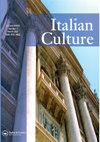From Intersectionality to Interstitiality: Pathways in Italian Race, Migration, and Diaspora Studies
IF 0.3
0 HUMANITIES, MULTIDISCIPLINARY
引用次数: 0
Abstract
AbstractIn recent years, the study of Italy’s contemporary migrant “crisis” has broadened into explorations of national biopolitics in transhistorical and transnational contexts. This article suggests some useful pathways between critical race theory and postcolonial theory to explore pressing questions related to race-based cultural politics and Italian national identity. It highlights critical race theory’s potential to enrich analyses of racializing discourses: for example, the concept of “interest convergence” is harnessed here to describe and understand the mechanisms of Italy’s “New Risorgimento,” i.e. its recent psychic unification through race-paranoia. The article also investigates possible applications of the widely (mis)used term “intersectionality” and explores some of the limits of both critical race theory and postcolonial theory, especially the ever-present risk of slippage back into preexisting essentialist identity categorizations. To avoid such slippages, the article suggests further exploration of theoretical conceptualizations of hybridity by two of postcolonial theory’s foundational scholars, Edward Said and Homi K. Bhabha, due to their emphasis on discourse analysis and “interstitiality” rather than intersectionality. It urges further examination of Italy’s questione della razza via interstitiality in order to introduce urgently-needed nuance into analyses of race, nationality, power, and cultural discourse. Finally, the article emphasizes the importance of deploying multiple theoretical approaches and stresses the need to work within a public-facing “global humanities” framework to explore and expose how racializing discourses generate detrimental manufactured anxieties and hate in contemporary societies. Creating a “sense of the commons” via such transnational and comparative approaches to analyzing biopolitical conflicts would build both inclusivity, and therefore strength, within democratic nations, institutions, and societies, thus allowing them to thrive once again.Keywords: biopoliticscritical race theorypostcolonial theoryhybriditymigrationsintersectionality Disclosure statementNo potential conflict of interest was reported by the author(s).Notes1 See Burdett (Citation2016), Andall and Duncan (Citation2010), Greene (Citation2012), Hawthorne (Citation2022), Lombardi-Diop and Romeo (Citation2012), and Pesarini and Tintori (Citation2020), among others.2 The center-right coalition won 43.7% of the vote in the Chamber of Deputies and 44.02% of the vote in the Senate. The center-left coalition, led by the Democratic Party, won 26.13% of the vote in the Chamber of Deputies and 26.32% of the vote in the Senate. The populist Movimento Cinque Stelle won 15.43% of the vote in the Chamber of Deputies and 15.53% of the vote in the Senate.3 Hungary under Viktor Orban, Poland’s Law and Justice Party, France’s Marine Le Pen, and the United Kingdom’s Euro-skeptic Tory government can be all viewed as examples of the successful implementation and normalization of xenophobic populist discourses in today’s Europe.4 https://www.amnesty.org/en/latest/news/2023/03/tunisia-presidents-racist-speech-incites-a-wave-of-violence-against-black-africans/5 I am borrowing this term from Kellyanne Conway’s inadvertently brilliant euphemism to mislabel mendacious information.6 See Angelo Del Boca, “Italiani brava gente?” Neri Pozza Ed, Citation2009.7 For a succinct yet comprehensive introduction to Critical Race Theory, see Richard Delgado and Jean Stefancic, Critical Race Theory: An Introduction (New York: New York University Press, Citation2017).8 I am referring to the famous aphorism attributed to Massimo D’Azeglio but now a part of the general national discourse on the meaning of Italian national unification: “Abbiamo fatto l’Italia, ora bisogna fare gli italiani.”9 The party officially changed its name from Lega Nord to Lega per Salvini Premier (LSP). However, it is branded for all public purposes simply as La Lega. The Lega Nord does still exist, but in what I would call an equivalent to a “phantom limb” – a part of the body that has been amputated, but whose lingering partial presence can still be felt as both a source of continuity and an irritating liability for the full rebranding of the new Lega. Past racisms such as that against the meridionali have not been magically eliminated completely, but they have been almost fully repressed and displaced due to the deliberate deployment of the twin discourses of migrant/race obsession and Euro-skeptic populism. Only time will tell how durable and potent this strategic discursive and psychic move will be, and how long the current race obsession will successfully continue to mask historical internal structural inequalities.10 See Shelleen Greene, Rosetta Giuliani Caponetto, and Jennifer Guglielmo and Salvatore Salerno’s volumes on the ambiguous racial positioning of Italians and mixed-race Italians.11 See work by SA Smythe and Julia Heim’s work on Queer Italian Studies, for example.12 These numbers are limited to legal residents. https://www.tuttitalia.it/statistiche/cittadini-stranieri-2019/13 For a groundbreaking and thought-provoking article on the issues facing BIPOC faculty in Italian Studies, read Deborah Parker’s “Race and Foreign Language.”14 Foucault (Citation2013).15 For a detailed exploration of the application of de/postcolonial theories of hybridity in the Italian context, please see Vetri Nathan, and Jacqueline Andall and Derek Duncan’s edited volume.16 See, for example, work being done on the Black Mediterranean by the Black Mediterranean Collective and edited volumes such as Transnational Italian Studies (Burdett and Polezzi Citation2020).Additional informationNotes on contributorsVetri NathanVetri Nathan is Associate Professor of Italian and Mellon Associate Professor of Global Racial Justice at Rutgers University. His research and teaching interests include Global Migrations and Postcolonial Theory, Environmental and Public Humanities, Food Studies, and Italian Cinema and Media Studies. His monograph, Marvelous Bodies: Italy's New Migrant Cinema was published in 2017 through Purdue University Press. He is also the founder and Principal Investigator of The Cybercene Lab at Rutgers University.从交叉性到间隙性:意大利种族,移民和散居研究的途径
参见萨·斯迈思和朱莉娅·海姆关于意大利酷儿研究的著作这些数字仅限于合法居民。https://www.tuttitalia.it/statistiche/cittadini-stranieri-2019/13关于BIPOC教师在意大利研究中面临的问题的开创性和发人深省的文章,请阅读黛博拉帕克的“种族和外语”。14福柯(Citation2013).15对于在意大利语境中应用de/后殖民混杂理论的详细探索,请参阅Vetri Nathan, Jacqueline Andall和Derek Duncan的编辑卷。16例如,参见黑地中海集体正在进行的关于黑地中海的工作,以及诸如《跨国意大利研究》(Burdett and Polezzi Citation2020)等已编辑的卷。作者简介:作者是罗格斯大学意大利语系副教授和梅隆大学全球种族正义系副教授。他的研究和教学兴趣包括全球移民与后殖民理论、环境与公共人文、食品研究、意大利电影与媒体研究。他的专著《奇妙的身体:意大利的新移民电影》于2017年由普渡大学出版社出版。他也是罗格斯大学赛博中心实验室的创始人和首席研究员。
本文章由计算机程序翻译,如有差异,请以英文原文为准。
求助全文
约1分钟内获得全文
求助全文

 求助内容:
求助内容: 应助结果提醒方式:
应助结果提醒方式:


